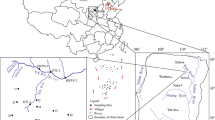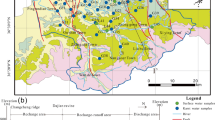Abstract
The present study explores the use of stable isotopes and major ion chemistry of various water sources such as mine water, groundwater, river water, and rainwater to identify the dominant hydrogeochemical process that controls the water quality in the active opencast coal mining area of the Korba Coalfield, India. Different hydrochemical models have revealed that the study area is mostly characterized by two facies alongside a dominance by ion exchange: i.e., a slightly mineralized Ca2+–Mg2+–Cl− and a meteorically derived Ca2+–HCO3− fresh water facies. In the isotope bivariate plot, the samples plot to the right of the LMWL and slopes observed in pre (4.94) and post-monsoon (5.85) seasons are not as steep as the LMWL (7.95) and this warrants the suggestion that meteoric water is the major source that replenishes the dynamic groundwater resource in the study area after being subjected to evaporation. The negative d-excess values (< 0) and enrichment of the δ18O ratio observed at some locations suggests a non-equilibrium process and a “mechanism of mixing”. A noteworthy fact is that isotopically river water is in tandem with the mine water samples for both seasons and testifies to a hydraulic connectivity between Hasdeo River water and mine water through a major fault. It is substantiated by mine inflows assessed by the sump test for Kusmunda and Gevra, which is two times higher than the predicted values by Darcy’s law. The wide variation in the isotopic composition is attributed to different vapor sources viz., southwest monsoon (SW) that originates in the Arabian Sea and locally driven air moisture from surface water bodies.






Similar content being viewed by others
Explore related subjects
Discover the latest articles and news from researchers in related subjects, suggested using machine learning.References
APHA (2005) Standard Methods for the Examination of Water and Wastewater, 21st edn. American Public Health Association/American Water Works Association/Water Environment Federation, Washington DC, USA
BIS (2012) Bureau of Indian Standards, Indian standard - drinking water specifications (Second Revision), IS: 10500: 2012, ICS13.060.20
Blasch KW, Bryson JR (2007) Distinguishing sources of ground water recharge by using d2H and d18O. Groundwater 45(3):294–308
Braaten R, Gates G (2003) Groundwater–surface water interaction in inland New South Wales: a scoping study. Water Sci Technol 48:215–224
Brahim YA, Benkaddour A, Agoussine M, Lemkademe AA, Yacoubi LA, Bouchaou L (2015) Origin and salinity of groundwater from interpretation of analysis data in the mining area of Oumjrane, Southeastern Morocco. Environ Earth Sci 74:4787–4802. https://doi.org/10.1007/s12665-015-4467-7
Brenninkmeijer CAM, Morrison PD (1987) Anautomated system for isotopic equilibration of CO2 and H2O for 18O analysis of water. In: New developments and applications in isotope geoscience: Chemical Geology. Isot Geosci Sect 66:21–26
Burnside NM, Banks D, Boyce AJ, Athresh A (2016) Hydrochemistry and stable isotopes as tools for understanding the sustainability of minewater geothermal energy production from a ‘standing column’ heat pump system: Markham Colliery, Bolsover, Derbyshire, UK. Int J Coal Geol 165:223–230. https://doi.org/10.1016/j.coal.2016.08.021
CECB (2011) Chhattisgarh Environment Conservation Board, Report on development of comprehensive environmental pollution abatement action plan for critically polluted area - Korba, Chhattisgarh, India
CGWB (2012) Central Ground Water Board, Aquifer systems of Chhattisgarh. North Central Chhattisgarh Region, Ministry of Water Resources, Government of India
Chen S, Gui H (2017) Hydrogeochemical characteristics of groundwater in the coal-bearing aquifer of the Wugou coal mine, northern Anhui Province, China. Appl Water Sci 7:1903–1910. https://doi.org/10.1007/s13201-015-0365-0
Clark ID, Fritz P (1997) Environmental isotopes in hydrogeology. CRC Press, Boca Raton, p 352
CMPDIL—Central Mine Planning and Design Institute Limited (2014) Geological Report on Coal Exploration Gevra, Dipka, Hardi, Ponri, Naraibodh- I & Naraibodh- II combined block, Korba coalfield, Korba (C.G.), India. CMPDIL, Coal India Ltd., India
Craig H (1961) Isotopic variations in meteoric waters. Science 133(3465):1702–1703
Cui B, Li X (2015) Characteristics of stable isotopes and hydrochemistry of river water in the Qinghai Lake Basin, northeast Qinghai-Tibet Plateau, China. Environ Earth Sci 73:4251–4263. https://doi.org/10.1007/s12665-014-3707-6
Drever JI (1997) The geochemistry of natural waters: surface and groundwater environments. Prentice Hall, New Jersey
Durov SA (1948) Classification of natural waters and graphic representation of their composition. Doklady Akad Nauk USSR 59:87–90
EIA/EMP (2014) Environmental Impact Assessment/Environmental management plan, Gevra opencast project, SECL area, Korba district, Chhattisgarh, India
Epstein S, Mayeda T (1953) Variations of 18O content of waters from natural sources. Geochim Cosmochim Acta 4:213–224
Fantong WY, Satake H, Aka FT, Ayonghe SN, Asai K, Mandal AK, Ako AA (2010) Hydrochemical and isotopic evidence of recharge apparent age and flow direction of groundwater in the Mayo Tsanaga River Basin Cameroon: bearings on contamination. Environ Earth Sci 60:107–120
Freeze JA, Cherry RA (1979) Groundwater, 1st edn. Prentice Hall, New Jersey
Gampson EK, Nartey VK, Golow AA, Akiti TT et al (2015) Physical and isotopic characteristics in peri-urban landscapes: a case study at the lower Volta River Basin, Ghana. Appl Water Sci https://doi.org/10.1007/s13201-015-0286-y
GNIP (2015) Global network of isotopes in precipitation. Water isotope system for data analysis, visualization and electronic retrieval (WISER). http://www-naweb.iaea.org/napc/ih/IHS_ resources_isohis.html. Accessed 11 July 2017
GSI—Geological Survey of India (1993) Final report on regional exploration for coal in the Bhelai East Area, South Central Part of Korba Coalfield, Bilaspur District, M.P., India
Handa BK (1979) Groundwater pollution in India. In: Proceedings of national symposium on hydrology. IAHS, Publication University of Roorkee, India, pp. 34–49
Hassen I, Hamzaoui-Azaza F, Bouhlila R (2016) Application of multivariate statistical analysis and hydrochemical and isotopic investigations for evaluation of groundwater quality and its suitability for drinking and agriculture purposes: case of Oum Ali-Thelepte aquifer, central Tunisia. Environ Monit Assess 188:135. https://doi.org/10.1007/s10661-016-5124-7
Ivkovic K (2009) A top-down approach to characterize aquifer–river interaction processes. J Hydrol 365:145–155
Jahanshahi R, Zare M (2015) Assessment of heavy metals pollution in groundwater of Golgohar iron ore mine area, Iran. Environ Earth Sci. https://doi.org/10.1007/s12665-015-4057-8
Kumar B, Rai SP, Kumar US, Verma SK et al (2010) Isotopic characteristics of Indian precipitation. Water Resour Res 46:W12548. https://doi.org/10.1029/2009WR008532
Kumar S, Venkatesh AS, Singh R, Udaybhanu G, Saha D (2018) Geochemical signatures and isotopic systematics constraining dynamics of fluoride contamination in groundwater across Jamui District, Indo-Gangetic alluvial plains, India. Chemosphere. https://doi.org/10.1016/j.chemosphere.2018.04.116
Liang MC, Ning ZG, Li YK, Song P, Wu N, Yang P (2015) Dynamic biofilm component in reclaimed water during rapid growth period. Environ Earth Sci 73:4325–4338. https://doi.org/10.1007/s12665-014-3717-4
Liang Z, Ren T, Ningbo W (2017) Groundwater impact of open cut coal mine and an assessment methodology: a case study in NSW. Int J Min Sci Technol 27:861–866. https://doi.org/10.1016/j.ijmst.2017.07.008
Mahato MK, Singh G, Singh PK, Singh AK, Tiwari AK (2017) Assessment of mine water quality using heavy metal pollution index in a coal mining area of Damodar River Basin, India. Bull Environ Contam Toxicol. https://doi.org/10.1007/s00128-017-2097-3
Oyarzu ́nR, Barrera F, Salazar P, Maturana H, Oyarzu ́ n J, Aguirre E, Alvarez P, Jourde H, Kretschmer N (2014) Multi-method assessment of connectivity between surface water and shallow groundwater: the case of Limar ́ı River basin, north-central Chile. Hydrogeol J 22(8):1857–1873
Parizi HS, Samani N (2012) Geochemical evolution and quality assessment of water resources in the Sarcheshmeh copper mine area (Iran) using multivariate statistical techniques. Environ Earth Sci 69(5):1699–1718
Parizi HS, Samani N (2014) Environmental isotope investigation of groundwater in the sarcheshmeh copper mine area, Iran. Mine Water Environ 33:97–109. https://doi.org/10.1007/s10230-014-0277-5
Piper AM (1944) A graphic procedure in geochemical interpretation of water analysis. Am Geophys Union Trans 25:914–923
Prada S, Figueira C, Aguiar N, Cruz JV (2015) Stable isotopes in rain and cloud water in Madeira: contribution for the hydrogeologic framework of a volcanic island. Environ Earth Sci 73:2733–2747. https://doi.org/10.1007/s12665-014-3270-1
Raja Rao CS (1983) Coal resources of Madhya Pradesh and Jammu & Kashmir; Bull. Geol. Surv. India Series A, No. 45, Coalfields of India III, pp. 1–204.
Rashid H, Hossain MS, Urbi Z, Islam MS (2014) Environmental impact of coal mining: a case study on the Barapukuria coal mining industry, Dinajpur, Bangladesh. Middle East J Sci Res 21(1):268–274. https://doi.org/10.5829/idosi.mejsr.2014.21.01.21213
Ray RK, Syed TH, Saha D, Sarkar BC, Reddy DV (2017) Recharge mechanism and processes controlling groundwater chemistry in a Precambrian sedimentary terrain: a case study from Central India. Environ Earth Sci 76:136. https://doi.org/10.1007/s12665-017-6435-x
Reddy AGS, Reddy DV, Kumar MS (2016) Hydrogeochemical processes of fluoride enrichment in Chimakurthy pluton, Prakasam District, Andhra Pradesh, India. Environ Earth Sci 75:663. https://doi.org/10.1007/s12665-016-5478-8
Schoeller H (1977) Geochemistry of groundwater. In: Brown RH, Konoplyantsev AA, Ineson J, Kovalevsky VS (eds) Groundwater studies: an international guide for research and practice. UNESCO, Paris, Chap 15, pp 1–18
Shen ZL, Zhu WH, Zhong Z (1993) Basic of hydrogeochemistry. Geol Press, Beijing (in Chinese)
Singh R, Syed TH, Kumar S, Kumar M, Venkatesh AS (2017a) Hydrogeochemical assessment of surface and groundwater resources of Korba coalfield, Central India: environmental implications. Arab J Geosci 10:318. https://doi.org/10.1007/s12517-017-3098-6
Singh R, Venkatesh AS, Syed TH, Reddy AGS, Kumar M, Kurakalva RM (2017b) Assessment of potentially toxic trace elements contamination in groundwater resources of the coal mining area of the Korba Coalfield, Central India. Environ Earth Sci. https://doi.org/10.1007/s12665-017-6899-8
Surinaidu L, Gurunadha Rao VVS, Srinu S, Srinu N (2014) Hydrogeological and groundwater modeling studies to estimate the groundwater inflows into the Coal Mines at different mine development stages using MODFLOW, Andhra Pradesh, India. Water Resour Ind 7:49–65. https://doi.org/10.1016/j.wri.2014.10
Tziritis EP, Datta PS, Barzegar R (2017) Characterization and assessment of groundwater resources in a complex hydrological basin of Central Greece (Kopaida basin) with the joint use of hydrogeochemical analysis, multivariate statistics and stable isotopes. Aquat Geochem. https://doi.org/10.1007/s10498-017-9322-x
UNESCO—United Nations Educational, Scientific and Organization C (1973) Ground-water studies, an international guide for research and practice. In Brown RH, Konoplyantsev AA, Ineson J, Kovalevsky VS (eds), Nuclear techniques in ground-water hydrology, ch 10, vol 7. UNESCO Studies and Reports in Hydrology, Geneva
Vermeulen PD, Burger M, Wyk AV, Lukas E (2014) Using Environmental isotopes in a coal mine and a gold mine to determine groundwater interaction. Mine Water Environ 33:15–23. https://doi.org/10.1007/s10230-013-0245-5
Wu Q, Fan S, Zhou W (2013) Application of the analytic hierarchy process to assessment of water inrush: a case study for the No. 17 coal seam in the Sanhejian coal mine, China. Mine Water Environ 32:229–238
Wu H, Zhang X, Xiaoyan L, Li G, Huang Y (2014) Seasonal variations of deuterium and oxygen-18 isotopes and their response to moisture source for precipitation events in the sub- tropical monsoon region. Hydrol Process 29(1):90–102
Yao M, Liu P, Shang M, Tao Y, Lei C, Cao L (2016) Determining sources of mine water based on hydraulic characteristics analysis of a fault system. Environ Earth Sci 75:858. https://doi.org/10.1007/s12665-016-5660-z
Zhan L, Chen J, Zhang S (2016) Spatial and temporal characteristics of 2H and 18O in the basin of Dongting Lake: impact of monsoon precipitation. J Radioanal Nucl Chem 307:479–490. https://doi.org/10.1007/s10967-015-4258-3
Acknowledgements
The authors express sincere thanks to CMPDIL, Ranchi, and Director, IIT (ISM), Dhanbad for according necessary permission to publish this paper. We acknowledge the editor and anonymous reviewers for improving the quality of the manuscript with their insightful comments. The first author is grateful to Dr. A. Subrahmanyam for his unflagging encouragement. The authors would also like to thank Mr. T. Chakraborty and Mr. T. Doley (Hydrogeology division, CMPDIL) and Dr. A.G.S. Reddy, CGWB, Raipur. The authors express sincere gratitude to Dr. Rama Mohan Kurakalva, National Geophysical Research Institute (NGRI), Hyderabad and National Institute of Hydrology, Roorkee, India for some of the analytical support. The views expressed in this paper are of the authors only and not necessarily of the organization to which they belong.
Author information
Authors and Affiliations
Corresponding author
Rights and permissions
About this article
Cite this article
Singh, R., Venkatesh, A.S., Syed, T.H. et al. Stable isotope systematics and geochemical signatures constraining groundwater hydraulics in the mining environment of the Korba Coalfield, Central India. Environ Earth Sci 77, 548 (2018). https://doi.org/10.1007/s12665-018-7725-7
Received:
Accepted:
Published:
DOI: https://doi.org/10.1007/s12665-018-7725-7




